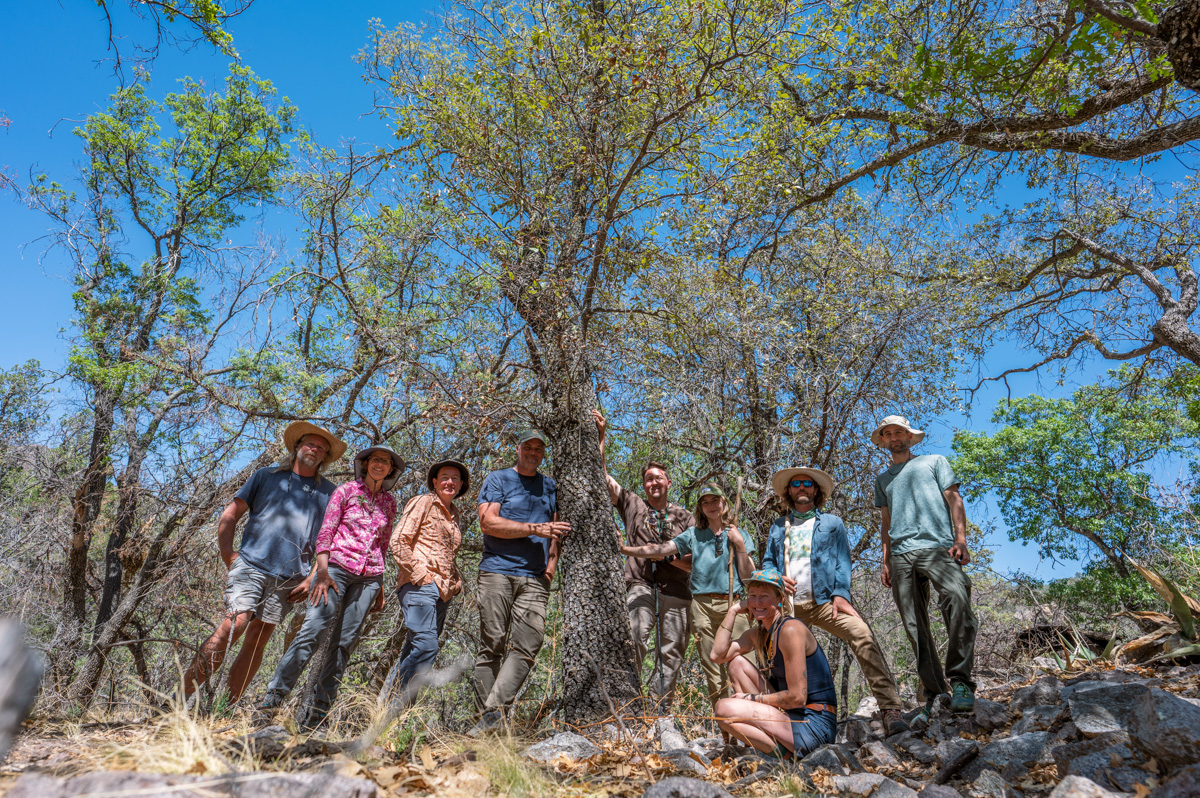
The Lost Oak of the Chisos: In Big Bend, a Win for Biodiversity Has Global Resonance
By Andrew Stuart
“These are the days of miracle and wonder, and don’t cry, baby, don’t cry.”
Those lines from a Paul Simon song resonate in a time of unprecedented and heartbreaking developments. Weather events that would once have been unheard of are now routine. And human impacts to the planet – specifically climate change and habitat destruction – are fueling a mass extinction unlike any Earth has witnessed since the dinosaurs died out.
But from time to time, there’s a win for biodiversity.
The oak species Quercus tardifolia had only been found in the Chisos Mountains of Big Bend National Park. And after the single known tree died in 2011, the species was thought to be lost forever. But a band of passionate botanists wasn’t having it. Now, they’re pulling this remarkable tree back from the brink of extinction.
Wesley Knapp is chief botanist for the conservation group NatureServe.
“It must have been late 2020,” Knapp said, “the word came that, ‘Alright, we’ve got some funding from the U.S. Botanic Garden to help do some survey work for this thing – do you want to go?’ And I was like, ‘Yeah – I’ll take vacation to make this thing happen.’ The stakes can’t be higher for conservation than rediscovering something like this.”
Knapp was part of the botanical team – drawn from arboretums and universities across the country – that set out this May in search of the Lost Oak of the Chisos.
Though the stakes may have been high, the quest stands out. Plants account for the majority of species threatened with extinction in the U.S. But animals get the attention. Less than 5 percent of endangered-species funding goes towards saving plants.
And Quercus tardifolia was uniquely rare and mysterious, even among endangered species. The tree was named by botanist Cornelius Muller, who encountered it near Boot Springs in the Chisos in 1932. A single known individual endured until 2011 – when it died, for reasons that are unclear.
Had Quercus tardifolia vanished from the planet with that tree? Or could there be others, hidden in the Chisos backcountry?
The botanists made camp near Boot Cabin. Each day, they fanned out and walked slowly through the rugged terrain.
And on day four, they encountered an oak tree unlike any other in the forest.
Michael Eason, a longtime Alpine resident and now associate director of conservation and curation at the San Antonio Botanical Garden, made the find.
“We looked at thousands if not tens of thousands of oak trees,” Eason said, “and you’re going up to almost every one and looking at it – if it looks a little different, we’d talk about it. But there was no question with this one. It was so distinctly different, that everyone as soon as they walked up was like, ‘This is it – we found it.’”
Oak identification is notoriously difficult – leaf-shapes often vary within a species, and during the lifetime of a single tree. And they have a unique capacity to hybridize. It’s possible Quercus tardifolia isn’t a “species” at all, but a hybrid of other oaks.
But the combined expertise of the field team that found this tree is substantial. Genetic analysis is underway now, at Chicago’s Morton Arboretum, to make a species determination. But Knapp said he trusts his eyes, and those of colleagues.
“I’m up for more information for sure,” he said. “But based on the normal skills and tools we all use, we all agree this thing is really different looking.”
This single, distinctive oak in the Chisos distills a vast story. Oak trees are the most abundant and most diverse of woody plants in North America – their ecological importance is profound. During tens of millions of years, they’ve spread from northern latitudes, adapting to inhabit diverse niches across the continent. Quercus tardifolia is likely a “climate relict.” The tree may have been widespread here in the cooler, wetter conditions of the Ice Age. Now, in the shaded confines of a single Chisos canyon, it’s found its final sanctuary.
The 30-foot tree is not in good shape. It’s been scarred by fire, and is infected with fungus. Adam Black is a rare-plant specialist, who was part of the team.
“I would say its days are numbered,” Black said. “I used to work for the forest pathology lab at University of Florida, so I’ve done a lot of tree assessments, and if this was in someone’s backyard or in a commercial landscape, I would recommend it be removed, because it’s a hazard.”
The botanists hope soon to travel to Mexico, to see if Quercus tardifolia can be found in the mountains opposite Big Bend. But they’re also collecting cuttings from the tree they found, for cultivation. Those trees could be reintroduced into the wild, or grown in arboretums – so that this living embodiment of the Big Bend’s natural heritage isn’t lost.
“Right now, vegetative propagation is what we need to do, first and foremost,” Black said, “and hope for getting that tree preserved and backed up in multiple botanic gardens, and hopefully getting some nice vigorous cultivated trees from which we can propagate further.”
Quercus tardifolia is certainly unique – it’s the rarest oak species in the country, and perhaps the world. But the sky islands of West Texas are a hotspot for oak diversity – and Eason said there’s more fieldwork to be done, to identify and preserve that richness.
“It’s not just the end,” he said. “It’s the beginning, of a lot more questions and a lot more work.”
Nature Notes is supported by the Shield-Ayres Foundation and produced by Marfa Public Radio with the Sibley Nature Center. The program can be heard each Tuesday and Thursday, at 7:45 a.m. and 4:45 p.m., Central time, on KRTS Marfa, 93.5 FM, and KXWT Odessa/Midland, 91.3 FM. This episode was written by Andrew Stuart.












